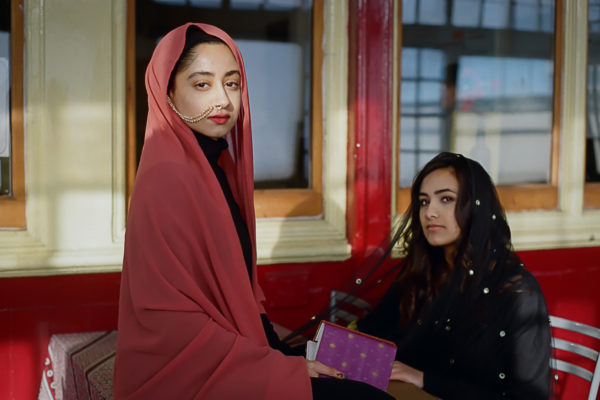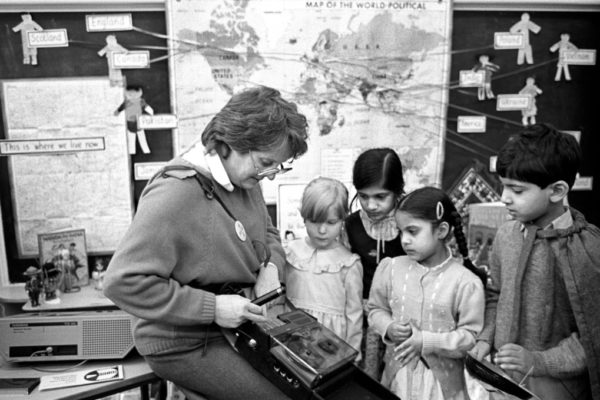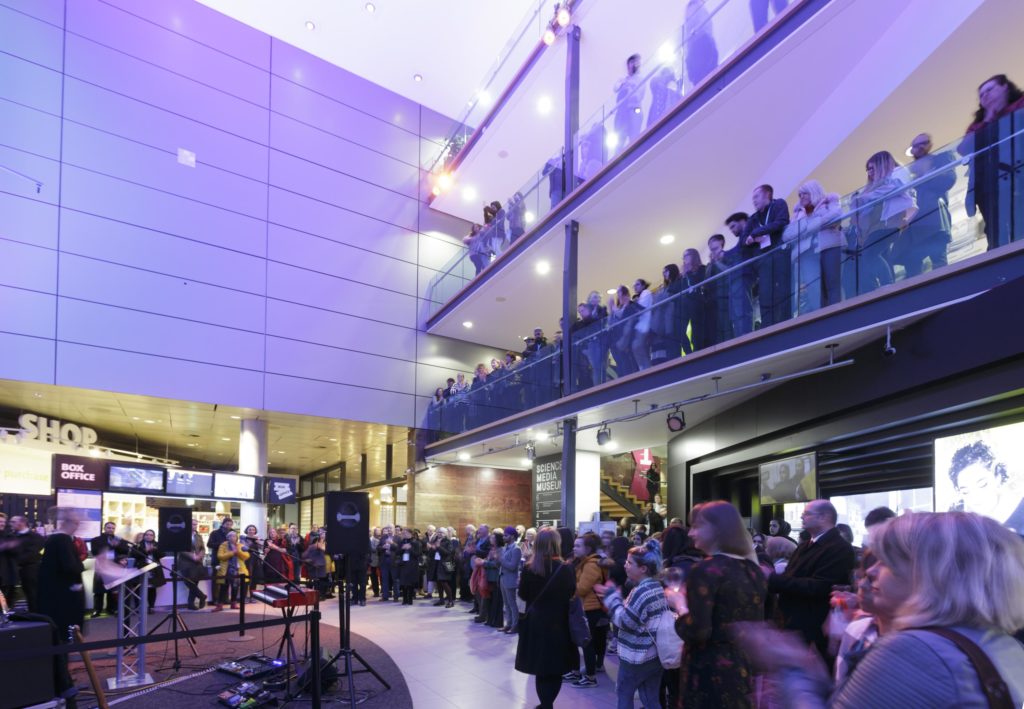Above the Noise Exhibition
We used a large collaborative exhibition called Above the Noise: 15 Stories from Bradford to help us explore how the National Science and Media Museum’s collections and themes could be combined with questions and issues that hold energy and interest for Bradford. The exhibition looked at how people in Bradford have addressed negative representations of Bradford in the national media through creating their own words, bypassing mainstream media and confronting power. We also used the process of making the exhibition to understand better the challenges created for the museum in seeking to work locally and collaboratively.
As an action research project, Bradford’s National Museum explored core research questions through experimentation. One of the ways we did this – a key aspect of our research design – was to make an exhibition (which opened to the public on 15th March 2019), halfway through the three-year project. We were particularly focused on understanding better how the museum can bring its collections and themes to issues which generate interest and energy in Bradford and how Bradford’s stories can open up new and distinctive ways of interpreting the museum’s collections.
Drawing on the strands of research from the first phase of the project – including the Open Conversations with lots of different people in Bradford – we decided to focus on how different communities in Bradford have made their own worlds by bypassing and confronting national power structures and mainstream media. In particular, we explored how people from Bradford recorded their own histories, created their own cultural spheres, made political and social change using local-to-local and alternative distribution networks by adapting or re-purposing available technologies.

Above the Noise: 15 Stories From Bradford posters. Image credit: Tim Smith and National Science and Media Museum / Science Museum Group.
Above the Noise: 15 Stories from Bradford – as the subtitle suggests – staged fifteen stories, the majority of which were developed in collaboration with people in Bradford who have a stake in their telling. 109 story collaborators were directly involved.
In the exhibition, stories were explored under three sub-themes which indicated the different strategies people in Bradford have taken in dealing with power and powerful media.
In a strand called ‘Create: Make your own world’, stories explored how people have used sound and vision technologies to keep in touch with people and places elsewhere. One story explored how studio photography (such as those taken in the Belle Vue Studio in Manningham) and changes in technology have shaped the way we take, keep and send family photographs. Another traced how cassettes were used to tape and send audio letters through the post and how the effects of convergence of these technologies on mobile phones offers new and different possibilities today. Yet another story explored how technologies of amplification, narrowcast, broadcast and mobile technologies are used by people in different ways to create Islamic soundscapes between mosques and people’s homes.

Sajidah and Mariyah from Belle Vue Girls Academy try on some family heirlooms after interviewing their parents and grandparents about journeys from Pakistan to Bradford. Image Credit: Nabeelah Hafeez
A second theme – ‘Bypass: Build alternatives’ – was inspired by the DIY culture of Bradford. It identified how people have set up their own media and communications and their own distribution networks. It told the story of two of our key collaborators BCB (Bradford Community Broadcasting), an internationally-recognised community radio station with over 200 volunteer presenters producing radio that reflects the cultural diversity of Bradford, and Fast FM, the station which successfully applied for Bradford’s first Restricted Service Licence (RSL), becoming the first Muslim RSL radio station in 1992
Another story in the Bypass theme took a closer look at the innovative Bradford Heritage Recording Unit, run by Bradford Council from 1983 until 2001 which concentrated on telling ‘history from below’ using people’s memories and their everyday experiences through recorded oral histories and photography.
The Bypass theme also explored Bradford’s Polish and Ukrainian communities who, displaced from their homelands by the Second World War, used their own media to help build their identities as communities in exile, as well as Asian film clubs and Bhangra daytime discos, where people created their own cultural experiences that were not available at the time, in Bradford or anywhere else in the UK.

In 1986 pupils marked the centenary of Tyersal Primary School in Bradford by doing an oral history session with a member of the Bradford Heritage Recording Unit. The Unit was part of Bradford Libraries & Museums and combined audio recording and documentary photography in innovative ways to create ground-breaking alternative histories of the Bradford District. Image credit: Tim Smith
A final section was ‘Confront: Make change’. This theme looked more directly at the negative representation of Bradford and its communities and explored ways in which these have been challenged. Displayed in this section were interviews with people who often find themselves approached to be the ‘voices’ of Bradford when national media stories break. Among them is Dr Martin Baines QPM (Queen’s Police Medal) who was appointed as Bradford’s first race relations officer from 1996 and was often the first point of contact for national media looking to report stories about the city’s social challenges. He talks about pioneering proactive work with Bradford’s South Asian publications and media outlets. In the same exhibit Paul Meszaros, a Bradford-based regional organiser for ‘Hope Not Hate’, argues for restraint and responsibility when reporting on complex matters.
In another story, we explored the Asian Youth Movement, formed in Bradford and other cities in the 1970s in response to racism across the UK. In Bradford, the Asian Youth Movement used self-published posters and newsletters to build regional and international networks, gaining prominence during the ‘Free the Bradford 12’ campaign. In 1981, rumours emerged that fascists were heading to Manningham and petrol bombs were subsequently found in the area. The fascists didn’t come, and the petrol bombs weren’t used, but 12 young Bradford men were arrested and charged with conspiracy. The 12 argued community self-defence and a newsletter was produced each day of the trial. They were ultimately acquitted in what is now seen as a turning point in race relations in this country.

The Free the Bradford 12 Campaign built links across the world, publishing their own news and making their own posters and t-shirts. Image credit: Anandi Ramamurthy
Above the Noise also included two original artworks. This included a new commission titled Moon Sighting by Basir Mahmood which explores Bradford as it is seen from Mirpur, Pakistan, where many of Bradford’s Pakistani community have their roots. The exhibition also featured a film piece by acclaimed artist Amar Kanwar entitled, Season Outside, which looks at the Pakistan and India border outpost Wagah-Atari. Kanwar has said, ‘A Season Outside is a personal and philosophical journey through the shadows of past generations, conflicting positions, borders and time zones’.
Finally, a Common Space was created in order to reflect on and discuss these stories. It also explored the histories of communal meeting spaces in Bradford and invited ideas for what an ideal future Common Space might be.
The BBC and We Are Bradford
Launching the same week as Above the Noise: 15 Stories from Bradford, the BBC kicked off an ongoing project called #BBCWeAreBradford with a special week of coverage from Bradford ‘giving the people who live here the opportunity to tell the stories that matter most to them’. We displayed the films produced by the BBC through We Are Bradford in the Above the Noise Gallery. In July 2019 the partnership led to an event reflecting on both Above the Noise and We Are Bradford, asking ‘What difference does media portrayal make to Bradford?’

We are Bradford event at the National Science and Media Museum, 2019. Image credit: National Science and Media Museum / Science Museum Group.
The idea behind the Above the Noise exhibition didn’t just provoke an interesting conversation – it was the catalyst for the BBC trying a new way of reporting the news. Above the Noise was the inspiration for the BBC’s We Are Bradford – a way of trying to reflect a wider and perhaps fairer picture of the city. This model of journalism is now being tried out in other cities following the success of what began in Bradford.
David Sillito, Media and Arts correspondent, BBC News
Informing the rest of the research project
The exhibition – alongside other strands of work that are ongoing – was used to inform the research agenda for the rest of the research project through the reflective process. As we moved into the post – Above the Noise phase of the project our aim was to create deeper understandings of the dynamics of the potential connections between the museum and its place.

Visitors at the exhibitions launch are gathering to listen to the opening speeches. It was the busiest exhibition opening the National Science and Media Museum has seen. Image credit: Anna Bridson for the Science and Media Museum / Science Museum Group
For a long time we were stuck as to how to build the exhibition concept from the ground up. We had invited our project partners and NSMM staff to come up with potential stories or case studies for the exhibition that could be uniquely told by this national museum — as a museum of sound and vision technologies that is in Bradford?
We had no shortage of potential ideas. But we had difficulty figuring out as a group how to make decisions about what the sum of the parts should be. What was the ‘big idea’ that could be pieced together from these episodes, yet still say something meaningful as a whole?
We tried pinning the ideas to a wall and writing about the connections we spotted on post-it notes. We tried coming together as bigger and smaller groups. We tried creating diagrams with circles of relevance to focus down the stories and make some cuts. We had endless discussions, some in the clinical level 7 NSMM meeting room with power-point presentations and catering on a trolley, some crammed together in level 9 with tea in chipped and often inappropriate slogan mugs, one as a break-away group with curry and a jug of mango lassi in My Lahore, one in the slick board room of a local cultural centre with help your-self herbal teas and Kenco in sachets. But with no resolution. We were going round in circles so much that vertigo was starting to set in. Everyone was frustrated.
Two things helped us together find a concept that could work: The first was giving things form by bringing all the possible material together in a Padlet — a virtual noticeboard that meant I could set out visually and simply what all of the potential stories were and arrange them to suggest a possible structure that didn’t seem too final. The second was cutting this up. Printing it all out in material form and taking the scissors to it. We brought the fragments along to the next meeting — this time in a rickety ex-pub with mismatched chairs that was too cold, but made proper coffee — and invited everyone to rearrange them into a whole by using a structure that made sense for them. Having the freedom to physically move the paper around and the tack to stick them in place momentarily helped everyone make new connections between the stories and find new ways to fit them together.
Lynn Wray, Research Facilitator



